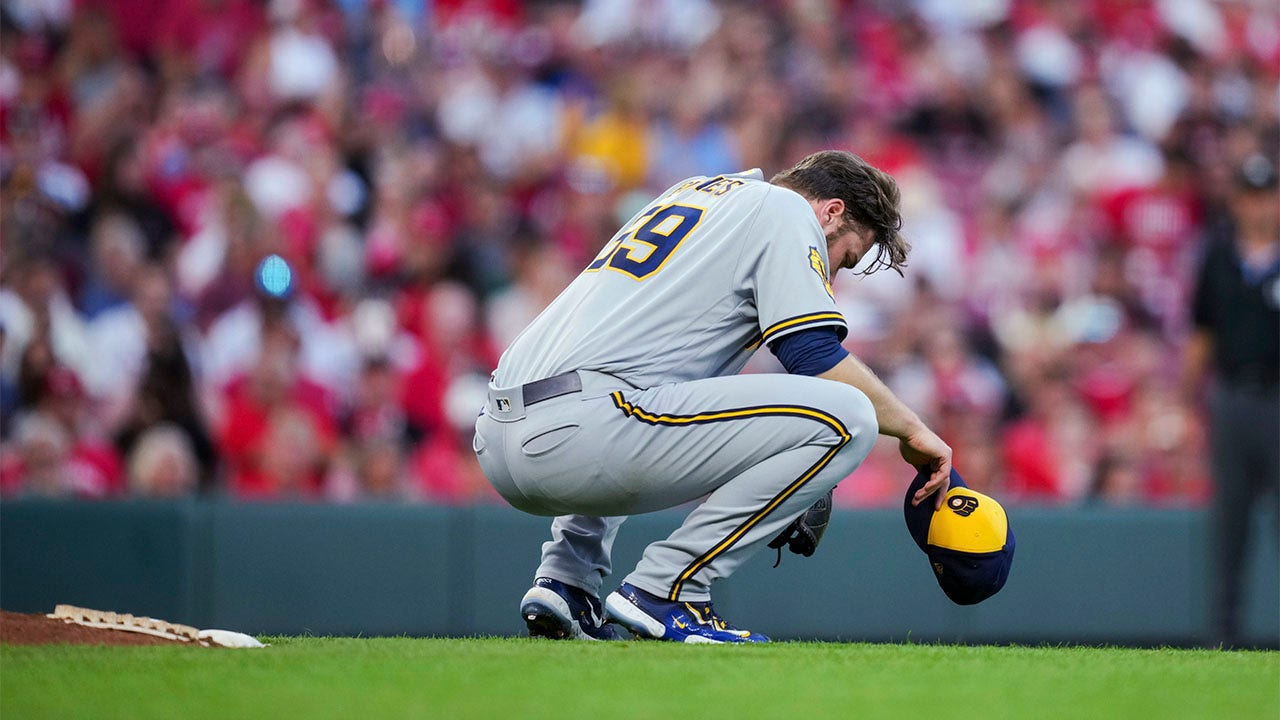How Corbin Burnes Outsmarts Batters with Surgical Precision delves into the Milwaukee Brewers pitcher’s masterful command of the strike zone and his ability to consistently outwit opposing hitters. This analysis explores Burnes’ diverse pitching repertoire, his strategic sequencing, and his remarkable adaptability on the mound, showcasing the meticulous planning and execution that define his success.
Burnes’ success isn’t merely about throwing hard; it’s about a calculated dismantling of the opposing batter. His arsenal, a carefully curated mix of fastballs, changeups, curveballs, and sliders, each with unique movement profiles, keeps hitters perpetually guessing. This article will examine specific pitch sequences, demonstrating how Burnes anticipates and exploits hitters’ weaknesses, turning each at-bat into a strategic chess match.
Corbin Burnes’ Pitch Repertoire: A Deep Dive
Corbin Burnes’ success stems from a diverse and highly effective arsenal of pitches. His ability to command each pitch with pinpoint accuracy allows him to consistently outsmart hitters at the highest level. This section details the specific characteristics of each pitch and their effectiveness against various batter types.
Pitch Arsenal and Effectiveness
Burnes primarily relies on four pitches: a four-seam fastball, a changeup, a curveball, and a slider. The fastball serves as his primary offering, setting up the off-speed pitches. His changeup, with its deceptive movement and velocity drop, is particularly effective against right-handed hitters. The curveball and slider provide sharp breaking action, keeping hitters guessing and inducing weak contact.
Against left-handed batters, Burnes often utilizes his slider more frequently to exploit their tendencies.
Get the entire information you require about Pachuca, la joya colonial escondida que te dejará sin aliento on this page.
Pitch Movement Profiles
Burnes’ fastball sits in the mid-90s mph, showcasing a slight arm-side run. His changeup, thrown with a similar arm slot, drops significantly in velocity, creating a dramatic deception. The curveball features a sharp 12-to-6 break, while the slider boasts a late, sweeping break across the plate. The combination of velocity, spin rate, and movement creates a unique profile for each pitch, making them difficult to square up.
Pitch Statistics
| Pitch | Average Velocity (mph) | Average Spin Rate (RPM) | Movement (inches) |
|---|---|---|---|
| Four-Seam Fastball | 94-96 | 2300-2500 | 6-8 inches of arm-side run |
| Changeup | 84-86 | 1800-2000 | 10-12 inches of downward movement |
| Curveball | 78-80 | 2800-3000 | 12-14 inches of 12-6 break |
| Slider | 86-88 | 2500-2700 | 8-10 inches of horizontal break |
Burnes’ Command and Control: The Art of Precision
Burnes’ command is legendary. His ability to consistently locate his pitches within the strike zone, even at the edges, is a key element of his success. This precision allows him to exploit hitters’ weaknesses and set them up for outs.
Pinpoint Accuracy and Exploitation of Hitter Weaknesses
Burnes’ command allows him to paint the corners of the strike zone, consistently challenging hitters with pitches they struggle to make solid contact with. For example, against right-handed pull hitters, he might consistently locate his fastball on the outside corner, setting up a devastating changeup on the inside. He frequently uses his slider to induce weak ground balls from left-handed hitters by placing it on the outer half of the plate.
Pitch Sequences
Burnes’ strategic approach involves meticulously sequencing his pitches to keep hitters off balance. He often mixes his fastball with his off-speed offerings, changing speeds and locations to create unpredictable patterns. This makes it difficult for hitters to anticipate his next pitch and time their swing properly.
- Fastball-Changeup-Slider sequence to right-handed hitters.
- Curveball-Fastball-Slider sequence to left-handed hitters.
- Fastball-Fastball-Changeup sequence to set up a later breaking ball.
Strategic Pitch Sequencing: Outsmarting the Opposition
Burnes’ masterful pitch sequencing is a testament to his advanced understanding of hitting tendencies and his ability to adapt his approach in real-time. He doesn’t just throw pitches; he strategically constructs sequences designed to exploit vulnerabilities.
Successful Pitch Sequences
Burnes often starts an at-bat with a fastball to establish velocity and location, then mixes in his off-speed pitches to keep hitters guessing. Against right-handed hitters, a common sequence might be a fastball high and away, followed by a changeup low and inside, then finishing with a slider breaking away. Against left-handed hitters, he might use a curveball low and away to set up a fastball inside, followed by a slider away.
The effectiveness of these sequences relies heavily on his pinpoint command.
Effectiveness of Pitch Sequences, How Corbin Burnes Outsmarts Batters with Surgical Precision
| Pitch Sequence | Effectiveness vs. RHH | Effectiveness vs. LHH |
|---|---|---|
| Fastball-Changeup-Slider | High whiff rate, weak contact | Moderate effectiveness, often leads to ground balls |
| Curveball-Fastball-Slider | Moderate effectiveness, can lead to ground balls | High whiff rate, weak contact |
| Fastball-Fastball-Changeup | Sets up later breaking balls effectively | Creates opportunities for strikeouts |
Adaptability and Adjustment: Reading the Batter
Burnes is not just a pitcher with a great repertoire; he’s a student of the game. He constantly analyzes hitters’ strengths and weaknesses, adjusting his approach mid-game and even mid-at-bat to maximize his effectiveness.
In-Game Adjustments
Burnes meticulously studies scouting reports before each game, noting hitters’ tendencies and vulnerabilities. During the game, he observes each hitter’s approach at the plate, noting their swing patterns, timing, and reactions to different pitches. Based on these observations, he adjusts his strategy, often abandoning a planned sequence if a hitter is showing signs of success against it. He might increase the frequency of a particular pitch if it’s proving effective, or switch to a different pitch entirely if the hitter is anticipating his offerings.
Examples of Mid-At-Bat Adjustments

In a crucial situation, Burnes might start an at-bat with a fastball outside to a right-handed hitter. If the hitter swings and misses, he might continue with the same sequence. However, if the hitter makes solid contact, Burnes might immediately switch to a curveball or slider to exploit a weakness revealed by the previous swing.
Mental Fortitude and Game Management: The Unsung Factor
Beyond his physical skills, Burnes possesses exceptional mental fortitude. His ability to remain calm and focused under pressure, coupled with his astute game management, is a significant contributor to his success.
Composure and Resilience

Burnes rarely lets setbacks affect his performance. Even after giving up a home run or walking a batter, he quickly regains his composure and focuses on the next hitter. His ability to remain even-keeled allows him to maintain his concentration and execute his game plan effectively.
Mental Approach to Success
Burnes’ mental approach emphasizes preparation and execution. He meticulously plans his approach to each hitter, considering their past performance, current form, and the game situation. He believes in trusting his preparation and focusing on executing his pitches with precision. This mental strength allows him to handle high-pressure situations with confidence and composure.
Illustrative Examples: Visualizing Burnes’ Mastery: How Corbin Burnes Outsmarts Batters With Surgical Precision
One memorable at-bat showcased Burnes’ dominance. Facing a powerful right-handed hitter known for his pull-hitting tendencies, Burnes started with a 95 mph fastball on the outside corner, just off the plate. The hitter swung and missed, clearly expecting an inside fastball. Next, Burnes threw a devastating 85 mph changeup, low and away. The hitter was completely fooled, offering a weak swing that resulted in an easy groundout.
The final pitch was a perfectly located slider away, showcasing his mastery of the strike zone.
In another instance, against a left-handed hitter known for his aggressive approach, Burnes started with a curveball in the dirt, forcing a swing and miss. He followed with a fastball inside, causing the hitter to hesitate and adjust his stance. Finally, he threw a slider away, again getting a weak ground ball for the out. This at-bat demonstrated his ability to change his approach and exploit different weaknesses.
Corbin Burnes’ dominance isn’t solely attributable to raw talent; it’s the product of meticulous preparation, exceptional control, and an almost preternatural ability to read hitters. His strategic approach, combined with his mental fortitude and adaptability, makes him one of baseball’s most formidable pitchers. By dissecting his techniques, we gain a deeper appreciation for the artistry and intellect behind his seemingly effortless success on the mound.



